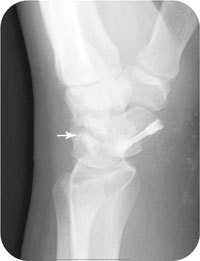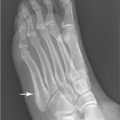George M. Bridgeforth, Kathryn J. Mccarthy, and Charles Carroll IV
A 33-year-old man complains of persistent wrist pain with limited range of motion. He notes moderate soreness with swelling of the left wrist. He has a history of left wrist injury and scaphoid fracture 10 months ago.

CLINICAL POINTS
- Kienböck’s disease is characterized by avascular necrosis of the lunate.
- The cause of the disease is not known.
- Degenerative arthritis may develop because of carpal instability.
Clinical Presentation
Kienböck’s disease is a disorder that involves the fragmentation and collapse of the lunate as a result of vascular insufficiency and avascular necrosis. The disease usually affects men between 20 and 40 years of age. It is more common in patients with negative ulnar variances (the ulna is shorter than the distal radius). It is thought that the short ulna does not provide adequate structural support to the neighboring lunate; however, the exact etiology is not clear. Kienböck’s disease is usually unilateral. Bilateral disease is very rare, which indicates that other factors such as the biomechanical stresses on the dominant hand and wrist come into play.
Pain and soreness over the lunate are characteristic of Kienböck’s disease. The pain and soreness occur just distal to the radius over a bony area at the center of the wrist (in line with the middle finger). Decreased grip strength in the hand may also be present. Physicians often misdiagnose acute cases as acute wrist sprains or contusions.
Associated findings include pain-limited range of motion. Moreover, patients with instability may complain of recurrent clicking. It is necessary to check neurovascular status carefully (cold cyanotic limb with numbness and diminished or absent pulses).
In Kienböck’s disease, the necrotic lunate characterized can lead to joint instability, hypermobility of the surrounding structures, and premature degenerative arthritis. The premature development of the arthritis results from carpal instability. Characteristics of the degenerative arthritis include joint hypertrophy, tenderness, stiffness, and pain-limited range of motion.
It is important to point out that patients who fall on the hypothenar eminence, the ulnar half of the palm, can sustain a fracture to the ulna, the triquetrum, the pisiform, or the hamate. Moreover, in an occupational setting, workers who use tools to strike objects can sustain fractures to the pisiform or the hook of the hamate. Patients often complain of pain, soreness, and swelling along the hypothenar eminence. Associate complaints are swelling and inability to grasp objects. Damage to Guyon’s canal (a tunnel formed by the pisiform and the hook of the hamate) may produce ulnar nerve damage. Patients report hypothenar pain and swelling associated with numbness of the hypothenar region, the fourth and the fifth fingers.
PATIENT ASSESSMENT 
- Pain, swelling, and tenderness over the lunate
- Pain-limited range of motion
- “Clicking” with carpal instability
Stay updated, free articles. Join our Telegram channel

Full access? Get Clinical Tree








